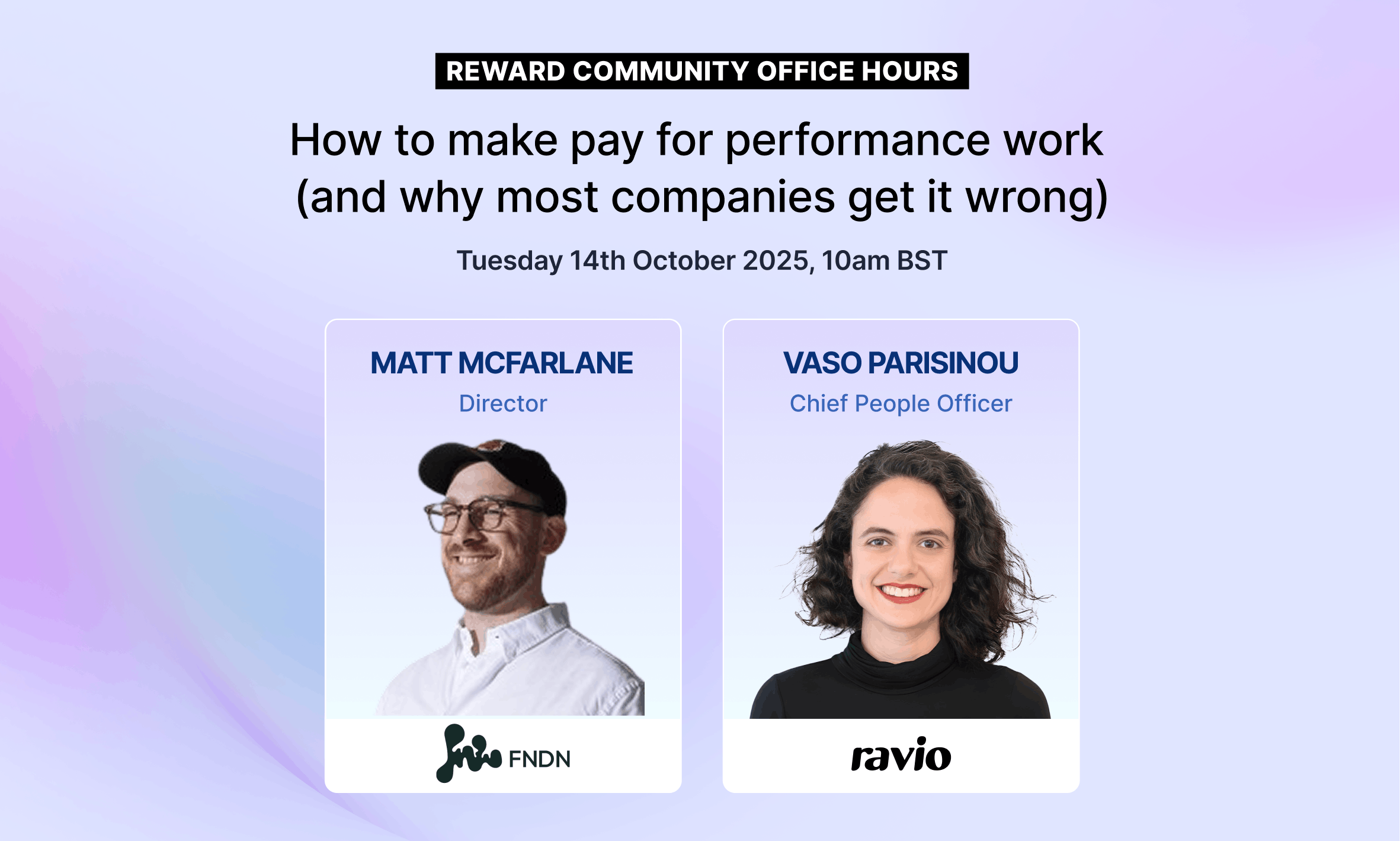Pay for performance is one of the most widely used and most debated practices in People and Reward. Linking compensation to performance through salary increases, bonuses, equity, or incentive plans can motivate employees, retain top talent, and align teams with company goals. But it can also bring challenges: subjective reviews, unhealthy competition, short-term thinking, and unnecessary stress.
In this month's Reward Community Office Hour, Matt McFarlane joined Ravio’s Chief People Officer, Vaso Parisinou, to explore the biggest challenges of pay for performance, sharing practical insights from his experience observing how countless businesses implement and manage these programmes.
The discussion included:
- How to set up a pay for performance model from scratch
- Merit increases vs other levers – what actually works to meaningfully reward performance
- How to avoid bias in performance evaluations damaging your approach
- How to communicate your pay for performance approach to the team.
Key takeaways from the webinar
If you're more of a reader than a watcher, here's a few of the most interesting insights from Vaso and Matt’s discussion on pay for performance.
Key takeaway 1: Define performance before choosing your programme
The most common mistake companies make is implementing a pay for performance programme without first clearly defining what "performance" means in their organisation. Businesses often adopt merit-based pay or bonus structures because they feel they should have them, rather than thinking through the behaviours and outcomes they want to incentivise.
Before implementing pay for performance, ask yourself:
- What does high performance look like in our organisation?
- Is this something that should be the baseline expectation or a stretch goal?
- Could focusing on this metric compromise collaboration, agility, or other values?
- Will this approach remain relevant as our business evolves?
💡 Practical application: Don't go too big too soon. Start with your compensation philosophy and performance definition before choosing your programme structure. Test the approach on a smaller scale or with a pilot group before rolling out company-wide. The framework should serve your business goals, not the other way around.
Key takeaway 2: Scale and structure matter
Pay for performance isn't one-size-fits-all. What works brilliantly for a 50-person startup can become problematic at 500 people, and vice versa.
For smaller companies (under 50 employees), discretionary bonuses work well thanks to close visibility of everyone’s impact. Keep them modest and unexpected to reinforce a culture of recognition without over-engineering the process.
For larger organisations, structured systems with clear ratings, goals, and calibrations ensure fairness and consistency. Once product-market fit is stable, formal frameworks – like 360 reviews – help reduce bias and keep performance management scalable across teams.
Key takeaway 3: Merit-based salary increases can have hidden costs
While merit-based pay increases are the most common pay for performance approach, they come with significant drawbacks that many companies underestimate:
Compounding inconsistencies: Over time, repeated top ratings can create large pay gaps between equally performing employees.
Rigidity challenge: Salary increases are permanent, making it hard to adjust for future performance or market changes.
Budget limitations: With limited budgets, small performance-based increases (2–5%) rarely motivate meaningful behaviour change.
Matt's preference leans toward keeping base salaries relatively flat within bands and using variable compensation (like profit sharing or discretionary bonuses) to reward exceptional contributions – separating ongoing compensation from one-time recognition.
Key takeaway 4: Creative alternatives can work when budgets are tight
Not every company can afford aggressive cash-based incentives, but there are creative approaches that can be surprisingly effective:
Paid sabbaticals: A growing favourite for recognising top performers, especially where work-life balance is an employee priority.
Peer-to-peer recognition: Colleagues often see the best work firsthand. Even small rewards can create strong morale and engagement.
Industry-specific perks: One startup Matt advises offers Azure cloud credits to employees – a low-cost, high-value benefit that supports growth and attracts the right talent.
Profit sharing: For profitable businesses, this builds a sense of shared ownership and aligns teams around collective success.
The key is understanding what truly motivates your specific talent pool rather than copying generic "best practices" that may not resonate.



